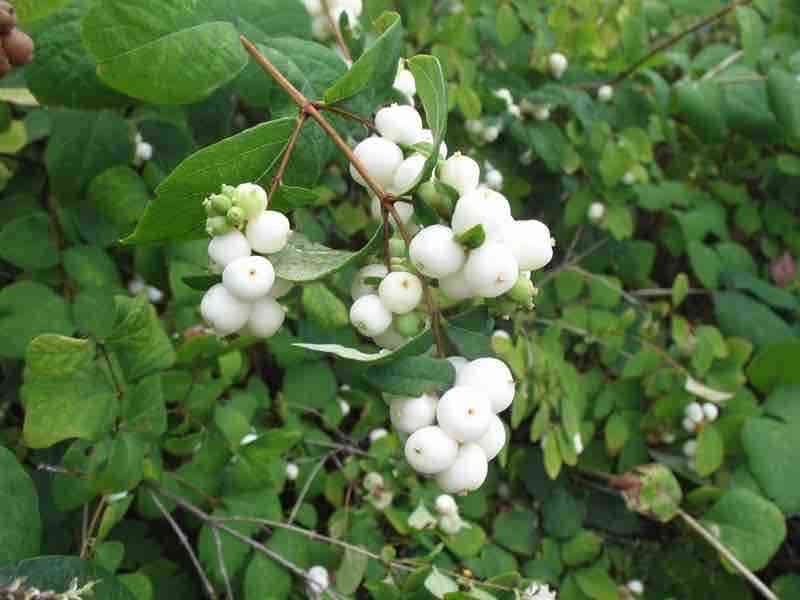Growing the Fuss-Free Snowberry
Photo:
MIssSuss via Pixabay
The Snowberry is a great addition to many types of landscapes or gardens as an ornamental shrub, as it is easy to care for and very low maintenance. Native to North America, snowberry shrubs are sometimes known as waxberry or ghostberry. Due to their deciduous nature, they shed their leaves in the winter season like many trees do. They are between 3 and 6 feet wide and 3 to 6 feet tall. Zones 3 through 7 are suitable for snowberry shrubs. They will tolerate moderate shade but prefer full light for growth. They may grow in any type of soil, from loam to clay, without showing any preference.
Appearance
Mid-May through July is when the shrubs blossom. Depending on the species, the flowers are either white or pink. Depending on the cultivar, the berries’ colors can range from white to pink to red. Most of them have white berries, which are where their names snowberry, waxberry, and ghostberry come from. Two seeds are present in every berry. Although the shrubs lose their leaves in the winter, the berries are still present until they are consumed by birds, which adds to their wintertime appeal.
Quick Growing Guide
Botanical Name: Symphoricarpos albus
Also Called: Wax-berry, Ghostberry
En français: Symphorine blanche
Blooms:
Sun / Shade:
Water: Low to moderate need for water.
Soil:
Height:

Plant Care
Snowberries are often fuss-free and trouble-free plants that are quite simple to grow. They are best grown as a hedge or as a component of a shrubbery because they can look a little untidy when grown alone. Plant outside in the early spring or autumn. Plants cultivated in containers can be planted outdoors at any opportune time of year.
Soil for Symphoricarpos Albus
In a variety of soils, snowberries can flourish. Although they do best in clay, these plants can also thrive in sandy and rocky soils. Snowberries are frequently found growing along streams and in marshy thickets, but they can flourish in arid regions.
Snowberry Water Requirements
Once the snowberry is established, give it regular waterings of about an inch each week. Once it has been established, it can go longer without water. Give this shrub extra water during particularly hot or dry spells, as it is drought-resistant.
Light
Snowberries can be grown in either full or partial shade. Although planting in half shade won’t prevent the plant from blossoming, full sunshine is optimal for flowering. Although it can be cultivated in complete shade, it cannot produce snowberries as effectively.
Temperature and Humidity
The plant is cold, hardy, and capable of resisting frost and surviving a harsh winter. As a zone 3 plant, it can tolerate temperatures as low as -40 F. It can tolerate all humidity levels.
Fertilizer
Fertilize the snowberry plant twice in the spring and mid-summer if the soil is clay or otherwise deficient in nutrients. Only fertilize once in the spring if your plants were planted in organic, enriched soil. Use a well-balanced, water-based 20-20-20 NPK fertilizer (nitrogen, phosphorus, potassium), or, if using granular fertilizer, aim to work 2 pounds of fertilizer into every 100 square feet of soil.
Pruning Snowberry
Before new growth starts, prune western snowberry during its dormant season in late winter or early spring. Flowers and fruit emerge on the snowberry’s new wood, and cutting during the growth phase will eliminate the summer-blooming blooms.
Western snowberry can be pruned to any desired size, but only as far upward as the first pair of buds. Any time of the year, prune away any branches that are dead, sick, or otherwise damaged. To improve the appearance of the plant, promote air circulation, and lower the danger of illness, cut off any crossed or rubbing branches.
Benefits
Because of its thicket-like growth pattern and tolerance of soils with low nutrient levels, the western snowberry is frequently used to curb erosion. It also offers additional environmental advantages.
In addition to attracting and feeding hummingbirds, butterflies, and bees, the snowberry serves as the host plant for the anicia checkerspot (Euphydryas chalcedona) butterfly. Small mammals eat the plant’s fruit and utilize it as cover, and birds and birds use the shrub’s dazzling white berries and nesting sites.
Other Uses
Saponin, a naturally soapy compound with antioxidant and antibacterial properties on the skin, is present in snowberry fruits. The skin can be cleansed and soothed by rubbing fresh berries on it; they can treat burns and rashes.
The berries were used by Native Americans to wash their hair. Tea prepared from twigs was used to treat fevers, and roots were soaked to make tea to alleviate digestive issues. Brooms can be made from spindly branches by tying them together. Humans cannot eat berries because they are unpleasant. When consumed in excessive quantities, they are regarded as toxic.







Leave a Reply
You must be logged in to post a comment.